ICSE Biology Previous Year Question Paper 2007 Solved for Class 10
ICSE Paper 2007 BIOLOGY
SECTION-I (40 Marks)
(Attempt all questions from this Section)
Question 1:
(a) Name the following:
(i) Cytoplasmic organelles that help in the manufacture of starch.
(ii) The statistical study of human population.
(iii) Pair of genes responsible for a particular characteristic in an individual.
(iv) A solution whose concentration is greater than that of the cell sap.
(v) The fluid that provides protection and nourishment to the cells of the brain. [5]
(b) State whether the following statements are true or false. If false, write the correct statement by changing the incorrect word / words only.
(i) Mortality is the number of deaths per thousand of the population per decade.
(ii) The symbiotic bacteria that helps in Nitrogen fixation is Rhizobium radicicola.
(iii) Rods are responsible for vision in the dark.
(iv) The dark reaction of photosynthesis is light independent.
(v) Process of fusion of the sperm nucleus and the egg nucleus is termed implantation. [5]
(c) Match the items in column A with those which are most appropriate in column B. You must rewrite the matching pairs :
| Column A | Column B |
| 1. Basic unit of life | A. Glucagon |
| 2. Beta cells of Pancreas | B. Meninges |
| 3. Meiosis | C. Iris |
| 4. Protective covering of the brain | D. Cell |
| 5. Constriction of the pupil of the eye | E. Insulin |
| F. Skin cell | |
| G. Protoplasm | |
| H. Sperm | |
| I. Ciliary muscles |
(d) Given below is an apparatus used to study a particular process in plants. Study the same and answer the questions that follow:
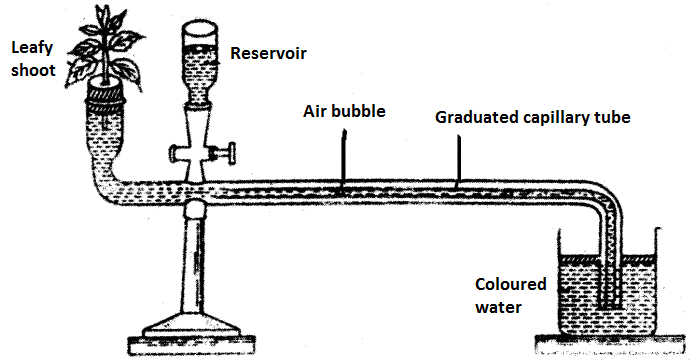 (i) Name the apparatus.
(i) Name the apparatus.
(ii) Mention one limitation of this apparatus.
(iii) Which phenomenon is studied with the help of this apparatus ?
(iv) What is the function of the part marked ‘reservoir’ ?
(v) What is the role of the air bubble in the experiment ? [5]
(e) In the box given below a list of biological terms that can be used to complete statements that follow. Select the appropriate term from the box and re-write the completed statement. You may use a term only once.
Concave, Neuron, Lactic acid, Glucose, Animal waste, Gestation, Nerve, Ethyl alcohol, Nephron, Myopia, DDT, Pregnancy, Convex.
(i) The type of lens uqpd to correct myopia is ……… .
(ii) The basic unit of the human brain is the ……… .
(iii) The end product of fermentation is ……….. .
(iv) A non-degradable pollutant is ……….. .
(v) The period of complete development of the foetus till birth is termed ………. . [5]
(f) Given below are the functions of certain organs I structures found in living organisms. In each case, name the organ or structure that:
(i) Produces testosterone.
(ii) Is responsible for protecting the eye from sweat.
(iii) Transmits characteristics from parent to offspring.
(iv) Transports water from the soil to other parts of the plant.
(v) Initiates cell division. [5]
(g) Explain the following terms:
(i) Tropic hormone
(ii) Guttation
(iii) Osmosis
(iv) Stereoscopic vision
(v) Mutation. [5]
(h) Given below is a set of terms arranged in logical sequence, representing a process or a function. Of these, one term is incorrect. Identify the incorrect term and replace it with the correct term. One has been done for you as an example.
Eg. Pollen grain —> Exine —> Staminal tube —> Male gametes —> Micropyle
Incorrect term — Staminal tube
Correct term — Pollen Tube
(i) Seminiferous tubule —> Sperm —> Sperm duct —> Accessory glands —> Semen —> Ureter.
(ii) Soil water —> Root hair —> Cells of cortex —>Epidermis —> Xylem.
(iii) Oxygen —> Stoma —> Respiratory cavity —> Mesophyll cells —> Oxidation of glucose —> A.T.P
(iv) Pupil —> Eye lens —> Vitreous humour —> Fovea —> Auditory nerve.
(v) Sensory nerve —> Dorsal root ganglion —> Sensory Neuron —> Motor neuron —> Receptor. [5]
Answer:
(a) (i) Chloroplast
(ii) Demography
(iii) Allele
(iv) Hypertonic
(v) Cerebrospinal Fluid
(b) (i) False. Mortality is the number of deaths per thousand of the population per year.
(ii) True.
(iii) True.
(iv) True.
(v) False. Process of fusion of the sperm nucleus and the egg nucleus is termed fertilization.
(c)
| Column A | Column B |
| 1. Basic unit of life | D. Cell |
| 2. Beta cells of Pancreas | E. Insulin |
| 3. Meiosis | H. Sperm |
| 4. Protective covering of the brain | B. Meninges |
| 5. Constriction of the pupil of the eye | C. Iris |
(d) (i) Ganong’s Potometer.
(ii) Any changes in the outside air temperature may affect the position of the air bubble in the capillary tube.
(iii) Transpiration.
(iv) Reservoir helps in bringing back the bubble to its original position. This can be done by releasing some water into the capillary tube by opening the stop-cock.
(v) The rate of water uptake can be calculated by timing the movement of air bubble over a fixed distance on the scale.
(e) (i) The type of lens used to correct myopia is Concave.
(ii) The basic unit of the human brain is the Neuron.
(iii) The end product of fermentation is Lactic acid.
(iv) A non-degradable pollutant is Animal Waste.
(v) The period of complete development of the foetus till birth is termed Gestation.
(f) (i) Interstitial cells of testes.
(ii) Eyebrows.
(iii) Genes.
(iv) Xylem.
(v) Centrosome.
(g) (i) Tropic Hormone: It refers to that hormones which stimulate other endocrine glands to produce their specific hormones.
(ii) Guttation: The process by which intact plant loses water in the form of droplets through pores (hydathodes) is called as guttation.
(iii) Osmosis: Osmosis is the diffusion of water molecules through a semi- permeable membrane from a dilute to concentrated solution.
(iv) Stereoscopic vision: When both the eyes are focussed on the same object but from different angles, it is called binocular or stereoscopic vision. All the monkeys, apes and particularly man have binocular vision.
(v) Mutation: Sudden changes in one or more genes or in the number and structure of chromosomes in the progeny, which normally may not have existed in^he parents, grand parents or even great grand parents.
Example: Albinism.
(h) (i) Incorrect term: Ureter.
Correct term: Penis.
(ii) Incorrect term: Epidermis.
Correct term: Optic Nerve.
(iv) Incorrect term: Auditary Nerve.
Correct term: Endodermis.
(v) Incorrect term: Receptors.
Correct term: Effectors.
SECTION-II (40 Marks)
(Attempt any four questions from this Section)
Question 2:
(a) Differentiate between the following on the basis of what is given in brackets :
(i) Bio-fertilizer and chemical fertilizer (an example of each).
(ii) Karyokinesis and Cytokinesis (Explain the terms).
(iii) WHO and Red Cross (Any one function of each).
(iv) Mitosis and Meiosis (Number of daughter cells formed).
(v) Pure and Hybrid strains (Definition). [6]
(b) Given below is the diagram of the human ear. Study the same and answer the questions that follow :
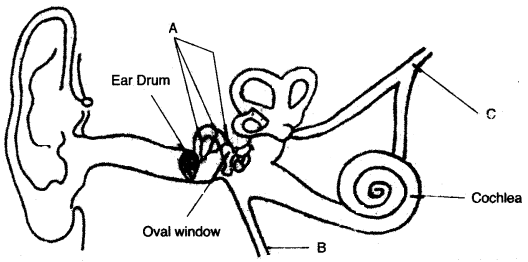 (i) Give the biological term for the part labelled ‘A’ and state its function.
(i) Give the biological term for the part labelled ‘A’ and state its function.
(ii) Name the part labelled ‘B’ and state its function.
(iii) Name the part labelled ‘C’ and state its function.
(iv) Give the function of ear wax. [4]
Answer:
(a)
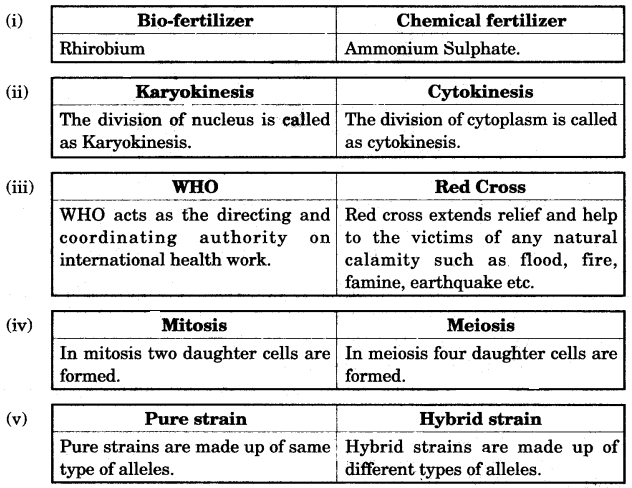
(b) (i) Part labelled ‘A’ is called as ear ossicles. It is made up of three bones malleus, incus and stapes. These ear ossicles transmit the sound waves from external to the internal ear.
(ii) Part labelled ‘B’ is called as eustachian tube. It acts as ventilator to equalize pressure of air on both the sides of tympanic membrane that forms the outer boundary of middle ear.
(iii) Part labelled ‘C’ is auditory nerve (vestibular and cochlear nerve) which carries hearing impulses to the brain.
(iv) Ear wax lubricates the tympanum for proper functioning.
Question 3:
(a) Answer the following questions briefly:
(i) Why is carbon dioxide considered an air pollutant ?
(ii) Name any two vaccines and mention the diseases against which they give immunity.
(iii) Mention two reasons for the high birth rate in India.
(iv) State two effects of the smog observed, in major cities. [5]
(b) Given below is an experiment, set up by a candidate, to study the process of respiration in plants. The candidate failed to get the expected results, as two mistakes were made while setting up the experiment:
 (i) Identify and state two mistakes made by the candidate.
(i) Identify and state two mistakes made by the candidate.
(ii) What is th&role of soda lime in the experiment ?
(iii) What is the purpose of using lime water in flask ‘A’ and ‘B’ ?
(iv) Give the chemical equation to represent the process of respiration. [5]
Answer:
(a) (i) Carbon dioxide is considered as an air pollutant. Because it mixses with oxygen present in air and forms carbon monoxide which is harmful to man, vegetation, animals or even buildings.
(ii) BCG vaccine is given against tuberculosis.
DPT vaccine is given against the diseases viz; Diptheria, Pertussis and Tetanus.
(iii) 1. Illiteracy
2. Desire for a male child.
Question 4:
(a) (i) Draw a neat and well-labelled diagram of the chloroplast.
(ii) List the events taking place in the photo-chemical phase of photo-synthesis.
(iii) If you are planning an experiment to shew the effect of light on photosynthesis:
(1) Will you select white light or green light ? Justify your answer.
(2) Why would you select a destarched plant ? [5]
(b) (i) Explain the term reflex action.
(ii) Expand the following biological abbreviations:
(1) DNA (2) AIDS.
(iii) State whether the following actions are ‘voluntary action, simple reflex or conditioned reflex’:
(1) Blinking
(2) Cleaning the table
(3) Playing on the keyboard
(4) Salivating when food is put in the mouth. [5]
Answer:
(a) (i)

(ii) Following events take place in the photo-chemical phase of photo¬synthesis :
(1) Activation of chlorophyll.
(2) Splitting of water (Photolysis).
![]()
(3) The hydrogen ions are picked up by a compound NADP to form NADPH.
![]()
(4) The oxygen component is given out as molecular oxygen.
2O ——> O2
(5) The electrons are used in converting ADP into energy rich compound ATP by adding one phosphate group P2.

(iii) (1) We will select white light because it will absorb green light and reflects other colours.
(2) We will select a destarched plant because destarching ensures that any starch present after the experiment has been formed under experimental conditions.
(b) (i) Reflex Action: Reflex action is an automatic, quick and involuntary action in the body brought about by a stimulus.
Reflexes are of two types : (1) Simple (natural) reflexes and (2) Conditioned (acquired) reflexes.
(ii) (1) DNA: Deoxyribose Nucleic Acid.
(2) AIDS: Acquired Immune Deficiency Syndrome.
(iii) (1) Blinking: Simple Reflex.
(2) Cleaning of table: Voluntary Action.
(3) Playing on Keyboard: Conditioned Reflex.
(4) Salivation when food is put in: Conditioned Reflex.
Question 5:
(a) Given below is a diagrammatic representation of a defect of the human eye :
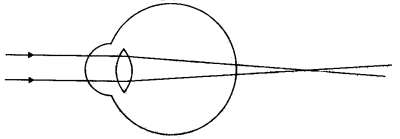 (i) Identify-the defect.
(i) Identify-the defect.
(ii) Mention two reasons for the above defect.
(iii) State how the defect can be rectified.
(iv) Name the part of the eye responsible for maintaining the shape of the eyeball. [5]
(b) Name the hormones which lead to the following conditions :
(i) Diabetes Mellitus Exophthalmic goitre.
(ii) Growth of beard in women
(iii) Myxedema
(iv) Gigantism [5]
Answer: (a) (i) “Hypermetropia” because the image is formed behind the retina.
(ii) Two reasons:
1. Shortening of the eyeball from front to back.
2. The lens is too flat.
(iii) The defect can be rectified by the use of convex (converging) lens.
(iii) Ciliary muscles control/maintain the shape of the eye ball.
(b) (i) Insulin.
(ii) Sex corticoids.
(iii) Thyroxin.
(iv) Somatotropin.
(v) Thyroxin.
Question 6:
(a) Study the diagram given below and then answer the questions that follow :
 (i) Name the parts labelled 1 and 2. State the function of each part.
(i) Name the parts labelled 1 and 2. State the function of each part.
(ii) State any one function of the amniotic fluid.
(iii) What’ is the role of the umbilical cord in the development of the foetus ?
(iv) Name the part in the diagram which is endocrine in nature. [5]
(b) (i) State Mendel’s law of Independent Assortment.
(ii) A homozygous Tall plant (T) bearing red coloured (R) flowers Amniotic Fluid is crossed with a homozygous Dwarf plant (t) bearing white flowers (r):
(1) Give the Genotype and Phenotype of the F1 generation.
(2) Give the possible combinations of the gametes that can be obtained from the F1 hybrid.
(3) Give the dihybrid ratio and the phenotype of the offsprings of the F2 generation when two plants of the F1 generation above are crossed. [5]
Answer:
(a) (i) Part labelled 1: Placenta: It helps in the nutrition, excretion and respiration of the embryo.
Part labelled 2: Chorion: It forms the placenta.
(ii) Amniotic fluid acts as a cushion for the embryo and protect it from jerks or mechanical shocks.
(iii) Umbilical cord contains blood vessels and connects the placenta with the foetus. It means it helps in providing nutrition to the embryo and O2 to foetus and removes CO2 and excretory wastes from foetus blood to maternal blood.
(iv) Endocrine part of this diagram is ‘placenta’.
(b) (i) Mendel’s law of Independent Assortment: When there are two pairs of contrasting characters, the distribution of the members of one pair into the gametes is independent of the distribution of the other pair.
(ii) (1) Genotype of the F1 generation – TtRr,
Phenotype of the F1 generation – Tall plant and Red flower.
(2) Possible combination of the gametes from F1 hybrid: TR, Tr, tR, tr.
(3) Dihybrid ratio and phenotype of the F2 generation:
![]()
Question 7:
(a) The diagram given below represents a stage during mitotic cell divisions in an animal cell:
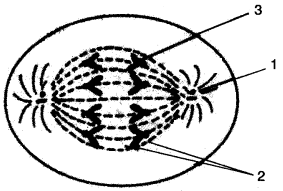 (i) Identify the stage. Give a reason to support your answer.
(i) Identify the stage. Give a reason to support your answer.
(ii) Name the parts labelled 1, 2 and 3.
(iii) What is the chromosome number of the cell ?
(iv) Draw a neat, labelled diagram of the cell as it would appear in the next stage. Name the stage. [5]
(b) Give reasons for the following:
(i) Plants begin to die when excess of soluble fertilizers are added to the soil.
(ii) Injury to the medulla oblongata results in death.
(iii) Gametes have a haploid number of chromosomes.
(iv) Green leaves are thin and broad.
(v) Lysosomes are termed suicidal bags of a cell. [5]
Answer:
(a) (i) This diagram represents ‘anaphase’ of the mitosis division. In this centromere is divided separating sister chromatids of each chromosome. They are now drawn apart towards opposite poles.
(ii) Parts labelled 1 —> aster rays.
Parts labelled 2 —> spindle fibres.
Parts labelled 3 —> chromatids.
(iii) 4 Chromosomes. Just double of the parent cell.
(iv) Stage: Telophase.
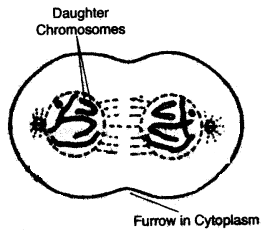
(b) (i) Because of plasmolysis of plant cells due to hypertonic solutions of fertilizers.
(ii) Because due to injury in medulla oblongata, the projecting process of the axis vertebra in the neck pierces it. As a result the involuntary actions such as breathing and heart beat are stopped.
(iii) Because gametes undergo meiosis (reduction) cell division in which the number of chromosomes becomes half.
(iv) Green leaves are thin and broad so that more surface area is exposed to sunlight for photosynthesis.
